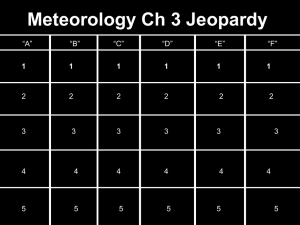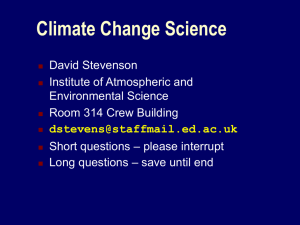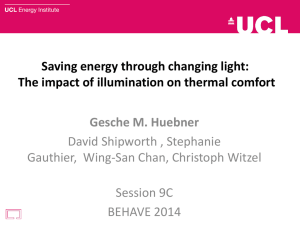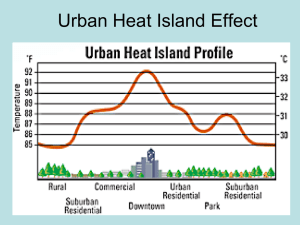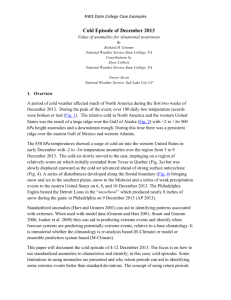15May2013 - Penn State University
advertisement
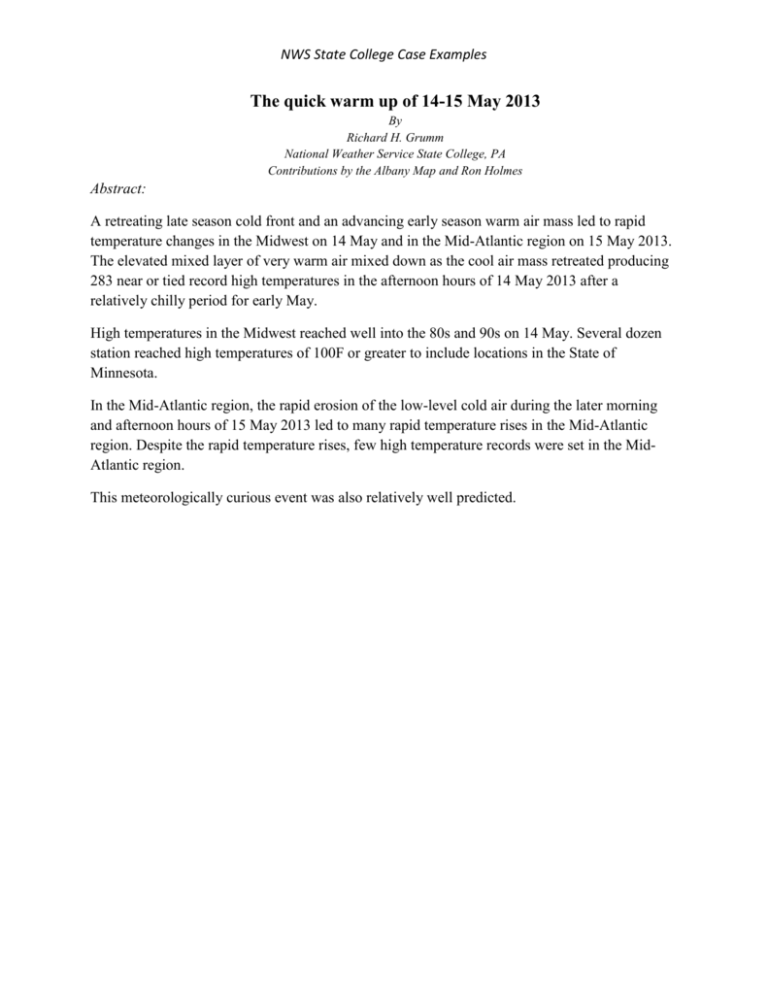
NWS State College Case Examples The quick warm up of 14-15 May 2013 By Richard H. Grumm National Weather Service State College, PA Contributions by the Albany Map and Ron Holmes Abstract: A retreating late season cold front and an advancing early season warm air mass led to rapid temperature changes in the Midwest on 14 May and in the Mid-Atlantic region on 15 May 2013. The elevated mixed layer of very warm air mixed down as the cool air mass retreated producing 283 near or tied record high temperatures in the afternoon hours of 14 May 2013 after a relatively chilly period for early May. High temperatures in the Midwest reached well into the 80s and 90s on 14 May. Several dozen station reached high temperatures of 100F or greater to include locations in the State of Minnesota. In the Mid-Atlantic region, the rapid erosion of the low-level cold air during the later morning and afternoon hours of 15 May 2013 led to many rapid temperature rises in the Mid-Atlantic region. Despite the rapid temperature rises, few high temperature records were set in the MidAtlantic region. This meteorologically curious event was also relatively well predicted. NWS State College Case Examples 1. Overview A period of rapid warming affected much of the central and eastern United States on 14-15 May 2013. A rapidly retreating cold air mass (Fig. 1) with 850 hPa temperatures running -1 to -2 below normal was rapidly replaced by an 850 hPa air mass with temperatures over +3 above normal in the upper Midwest and about +2 above normal in the Mid-Atlantic region (Figs. 1cf). The rapid warm up produced temperatures in the 80s, 90s, and lower 100s across the Midwest on 14 May leading to rapid snow and ice melt in some locations and new record high temperatures. Sioux City Iowa recorded a high temperature of 106F on 14 May beating the previous record of 97F set in 2001 and set a new monthly record high displacing the 105F reading set on 30 May 1934. Several sites in Minnesota broke 100F on 14 May 2013 though most locations recorded high temperatures in the 80s and 90s except near frozen lakes where temperatures were considerably colder. The Twin cities reached 98F breaking the record high of 95 set in 1932 and setting a new early season high temperature record. Shelborne and Winnebago MN recorded high temperatures of 103F and 102F respectively. The high temperatures and record high temperatures were attributed to the warm dry air mass which moved over the region. In many locations the delayed start to spring and minimal green-up may have played a role in the temperature extremes. As the warm air mass moved eastward it produced warm conditions in the Mid-Atlantic region which included a rapid warm-up in portions of central Pennsylvania in 15 May. The retreating cold air mass and surface anticyclone (Fig. 2) kept low-level cold air in place through around 1200 to 1500 UTC on 15 May 2013 (Fig.3). Temperature rises of 20 to 30F were experienced at nearly all ASOS and AWOS sites in central Pennsylvania during the early afternoon hours of 15 May 2013 as the low-level cold air was rapidly mixed out. In the Mid-Atlantic region the rapid temperature increases were more impressive than the high temperatures achieved. This paper the meteorological conditions associated with the rapid warm up and record warmth in the central United States and the rapid warm-up in the Mid-Atlantic region. The focus is on the pattern and the anomalies of key fields associated with temperature extremes. 2. Data and Methods The large scale pattern was reconstructed using the Climate Forecast System as first guess at the verifying pattern. The standardized anomalies were computed in Hart and Grumm (2001). All data were displayed using GrADS (Doty and Kinter 1995). Temperature data were retrieved from NCDC. The record high high-temperature data during the event and record low-temperature data data leading up to the event were examined. A summary NWS State College Case Examples of record highs set from 14-17 May is summarized in Table 1. A daily summary of temperatures above 100F on 14 May, recorded on the morning of 15 May is show in Table 1. Similar data were produced for low temperature data but are not shown here. Day New Records Ties Total 14 May 84 41 125 15 May 62 221 283 16 May 20 19 39 17 May 10 8 18 Table 1. Record Highs tied or broken and total number of records for the dates shown. Data based on NCDC data site. 3. Pattern over the region Table 1 shows the number of daily high temperature records set or tied during the period from 14-17 May 2013 and Table 2 lists the data for stations which reached a high of 100F or greater on 15 May 2013. Listing sites that achieved 90F or greater would require around 180 more rows of data. Despite the rapid warm up in the Mid-Atlantic region on 15 May 2013 few record high temperatures were set, thus there were few records recorded on 16 May 2013. The larger scale pattern from 11-16 May 2013 (Fig. 5) shows a deep trough over the central United States at 11/1200 UTC. This deep trough progressed eastward bringing cold air and some record lows to the central and eastern United States 81, 168, and 181 record lows were set or tied respectively on12, 13 and 14 May 2013. As the 500 hPa trough moved eastward, the large ridge along the West Coast moved into the central United States (Figs. 5b-d). The surge of warm air was accompanied by a models surge in the precipitable water (PW:Fig 6.). The PW data imply that some of the regions where the rapid warm up was observed in the Midwest on 14 May, such as Minnesota and Iowa had relatively moisture columns, perhaps outside the boundary layer, as the PW values were in the 25 to 30mm range as analyzed by the CFS1 and were 1 to 2 above normal. The sounding from Omaha (Fig. 7) showed a PW value near 20mm at 14/1200 UTC which was within 5mm of the CFS value at that point and time. 4. RAP The RAP analysis of hourly of 2m temperatures in increments showed the warm up over Pennsylvania (Fig. 8) as temperatures nearly -1 below normal were replaced by temperatures over 2above normal in the span of under 6 hours. Many locations had 5-hour temperature changes of 4-8C. The RAP forecasts (Fig. 9) from 1500 UTC showed the rapid warm-up and the RAP forecasts tended to be warmer than the RAP analysis. The salient point was that short-term high resolution models predicted the relatively rapid warm-up quite well. 1 There were some clear dew point errors in the NCEP GFS this day with low-level dew points running over 5C above observed values. It is unclear if this impacted the CFS analyzed moisture fields. NWS State College Case Examples Though not shown, part of the success in these forecasts was the presence in model sounding of the elevated well mixed layer just above the remnant cold air in the boundary layer. Once the cold air mixed out the potential for temperatures to increase rapidly were present in the model forecasts. The rapid temperature rise was generally well predicted in most forecast guidance. The 15/0900 UTC SREF (Fig. 10) showed a rise at a point near State College from 40F to about 76F. The high temperature was relatively low relative to observations which peaked out at about 80F (Fig. 3). 5. Summary A retreating late season cold front and an advancing early season warm air mass led to rapid temperature changes in the Midwest on 14 May and in the Mid-Atlantic region on 15 May 2013. The elevated mixed layer which mixed down the warm air as the cool air retreated produced 283 near or tied record high temperatures in the afternoon hours of 14 May 2013 (Table 1) and there were 10s of Stations which reached high temperatures of 100F or greater (Table 1). Few high temperature records were set in the Mid-Atlantic region though there were locations which had remarkable temperature increases on 15 May. The cold spring and cold air mass which impacted the eastern United States on mother’s Day weekend 2013 likely contributed to the large temperature swings. This air mass had several days of low temperature records in the central United States before the warm air mass moved into the region. The observed high and low data for Minneapolis-St Paul (Fig. 11) show the cold period from March through late April. The warm surge and record high on 14 May came after a cold period which was proceeded by two weaker warm surges. The event was meteorologically interesting, but not necessarily meteorologically significant like a tornado or hurricane. The event was also relatively well predicted by the NCEP models. It was a rare chance for forecasters to improve upon guidance as guidance typically does not perform well predicting record high temperatures. But the case also demonstrates the value of high resolution models in predicting rapid changes as synoptic scale patterns evolve. 6. Acknowledgements Albany Map for data and comments related to the rapid warm up of 14-15 May 2013. 7. References Coniglio, Michael C., Harold E. Brooks, Steven J. Weiss, Stephen F. Corfidi, 2007: Forecasting the Maintenance of Quasi-Linear Mesoscale Convective Systems. Wea. Forecasting, 22, 556–570. doi: http://dx.doi.org/10.1175/WAF1006.1 NWS State College Case Examples Doty, B.E. and J.L. Kinter III, 1995: Geophysical Data Analysis and Visualization using GrADS. Visualization Techniques in Space and Atmospheric Sciences, eds. E.P. Szuszczewicz and J.H. Bredekamp, NASA, Washington, D.C., 209-219. Gallus, W.A., N.A. Snook, and E.V. Johnson, 2008: Spring and Summer Severe Weather Reports over the Midwest as a Function of Convective Mode: A Preliminary Study. Wea. Forecasting, 23, 101–113. Johns, R. H., and W. D. Hirt, 1987: Derechos: widespread convectively induced windstorms. WeatherForecasting, 2, 32-49. Klimowski, B.A., M.R. Hjelmfelt, and M.J. Bunkers, 2004: Radar Observations of the Early Evolution of Bow Echoes. Wea. Forecasting, 19, 727–734. Rasmussen, E.N. and S. A. Rutledge, 1993: Evolution of Quasi-Two Dimensional Squall Lines. Part 1: Kinematic and Reflectivity Structure. J. Atmos. Sci. ,50, 2584-2606. Schmocker, G.K., R.W. Przybylinski, and Y.J. Lin, 1996: Forecasting the initial onset of damaging downburst winds associated with a Mesoscale Convective System (MCS) using the Mid-Altitude Radial Convergence (MARC) signature. Preprints, 15th Conf. on Weather Analysis and Forecasting, Norfolk VA, Amer. Meteor. Soc., 306-311. Weisman, M. L., and R. Rotunno, 2004:“A theory for strong long-lived squall lines” revisited. J. Atmos. Sci.,61,361–382. ——, J. B. Klemp, and R. Rotunno, 1988: Structure and evolution of numerically simulated squall lines. J. Atmos. Sci., 45, 1990–2013 NWS State College Case Examples Weaver, S. C., and S. Nigam, 2008: Variability of the Great Plains low level jet: Large scale circulation context and hydroclimate impacts. J. Climate,21,1532–1551. RECORD EVENT REPORT NATIONAL WEATHER SERVICE SIOUX FALLS SD 205 PM CDT TUE MAY 14 2013 ...RECORD DAILY AND MONTHLY MAXIMUM TEMPERATURE SMASHED AT SIOUX CITY IA... AT 135 PM THE TEMPERATURE REACHED 106 DEGREES AT THE SIOUX CITY GATEWAY AIRPORT ESTABLISHING A NEW RECORD DAILY MAXIMUM TEMPERATURE FOR THIS DATE AND A NEW RECORD FOR THE HIGHEST TEMPERATURE FOR THE MONTH OF MAY. THE PREVIOUS RECORD DAILY MAXIMUM TEMPERATURE WAS 97 DEGREES SET IN 2001 AND THE PREVIOUS RECORD MONTHLY MAXIMUM TEMPERATURE FOR MAY WAS 105 DEGREES SET ON MAY 30, 1934. THE TOP TEN HIGHEST TEMPERATURES FOR MONTH OF MAY FROM 1889 TO 2013 DEGREES 1. 2. 3. 4. 5. 6. 7. 8. 9. 10. 105 103 102 102 101 100 99 99 98 98 DATE 5/30/1934 5/29/1934 5/25/1967 5/31/1934 5/15/2001 5/06/1934 5/19/1934 5/18/1934 5/28/2006 5/24/1939 NWS State College Case Examples Figure 1. CFS plots of 850 hPa temperatures and temperature anomalies in 12 hour increments from a) 1200 UTC 13 May 2013 through f) 000 UTC 16 May 2013. Return to text. NWS State College Case Examples Figure 2. As in Figure 2 except for CFS mean sea-level pressure (hPa) and pressure anomalies. Return to text. NWS State College Case Examples Figure 3. Hourly plots of surface temperatures and dew points at (upper) University Park Airport and (lower) Clearfield. Data courtesy of Ron Holmes. Return to text. NWS State College Case Examples Figure 4. NCDC number and location of record highs set or tied on 14 May 2013. Due to data collection times dates are scored as the following morning and appear as 15 May 2013 records. Return to text. NWS State College Case Examples Figure 5. As in Figure 1 except for 500 hPa heights and height anomalies in 24 hour intervals from a) 1200 UTC 11 May through f) 1200 UTC 16 May 2013. Return to text. NWS State College Case Examples NWS State College Case Examples DATE REC PREV PREV DATE POR ST NAME 5/15/2013 107.1 107.1 5/15/1988 32 CA BAKER 5/15/2013 106 106 5/15/2006 44 AZ BEAVER DAM 5/15/2013 102.9 91.9 5/15/2007 115 IA ALGONA 3 W 5/15/2013 102.9 93 5/15/2001 110 MN WINNEBAGO 5/15/2013 102.9 91.9 5/15/1991 115 NE TEKAMAH 5/15/2013 102.9 96.1 5/15/2001 96 NE WALTHILL 1E 5/15/2013 102.9 93.9 5/15/2001 113 NE DAVID CITY 5/15/2013 102 93.9 5/15/1988 104 IA POCAHONTAS 5/15/2013 102 91 5/15/2001 110 IA FORT DODGE 5NNW 5/15/2013 102 96.1 5/15/2001 98 MN WASECA EXP STATION 5/15/2013 102 91.9 5/15/2001 115 NE FREMONT 5/15/2013 102 90 5/15/2001 62 NE TRENTON DAM 5/15/2013 100.9 93 5/15/1988 109 IA BRITT 5/15/2013 100.9 90 5/15/2001 105 IA JEFFERSON 5/15/2013 100.9 91 5/15/2001 120 IA LOGAN 5/15/2013 100.9 90 5/15/2001 114 IA ROCKWELL CITY 5/15/2013 100.9 98.1 5/15/2001 115 IA LE MARS 5/15/2013 100.9 89.1 5/15/2001 64 IA CASTANA EXP FARM 5/15/2013 100.9 95 5/15/2007 47 KS NORTON DAM 5/15/2013 100.9 91.9 5/15/2007 117 MN ALBERT LEA 3 SE 5/15/2013 100.9 93.9 5/15/1941 117 NE RAVENNA 5/15/2013 100.9 93 5/15/2001 48 NE CANADAY STEAM PLANT 5/15/2013 100.9 96.1 5/15/1931 111 NE CURTIS 3NNE 5/15/2013 100.9 89.1 5/15/1962 58 NE MEDICINE CREEK DAM 5/15/2013 100.9 91.9 5/15/2001 97 NE OSCEOLA 5/15/2013 100.9 96.1 5/15/2001 115 NE WAKEFIELD 5/15/2013 100 89.1 5/15/2007 70 IA MAPLETON NO.2 5/15/2013 100 93.9 5/15/2001 91 IA CHEROKEE 5/15/2013 100 91.9 5/15/2001 66 IA EMMETSBURG 5/15/2013 100 93 5/15/2001 102 IA SIBLEY 3 NE 5/15/2013 100 91.9 5/15/2001 116 IA CARROLL 5/15/2013 100 97 5/15/1931 86 KS ATWOOD 5/15/2013 100 91 5/15/2007 72 MN AUSTIN WASTE WATER TREATMENT 5/15/2013 100 90 5/15/2007 54 NE SUPERIOR 4E 5/15/2013 100 97 5/15/1915 72 NE GREELEY 5/15/2013 100 93 5/15/1944 114 NE WEST POINT 5/15/2013 100 97 5/15/1941 114 SD VERMILLION 2 SE Table 2. List of NCDC data where temperatures exceed 100F on 15 May 2013. Data includes the date, record for the date, previous record and the date of that record, the period of record for the station, the State and the town or Station name or ID. Return to text. NWS State College Case Examples Figure 6. As in Figure 6 except for precipitable water (mm) and precipitable water anomalies in 12 hour increments from a) 1200 UTC 13 May through f) 0000 UTC 16 May 2013. Return to text. NWS State College Case Examples Figure 7. Sounding from Omaha, Nebraska at 1200 UTC 14 May 2013. Sounding courtesy of Lance Bosart and the Albany map. Return to text. NWS State College Case Examples Figure 8. NCEP RAP analysis of 2m temperatures in 1-hourly increments from a) 1500 UTC through f) 2000 UTC 15 May 2013. Values in C. Return to text. NWS State College Case Examples Figure 9. As in Figure 8 except for RAP forecasts initialized at 1500 UTC 15 May 2013. Return to text. NWS State College Case Examples Figure 10. NCEP SREF initialized at 0900 UTC 15 May 2013 showing a) 2m temperatures ( F), b) 850 hPa temperatures (C ) and, c) 7700 hPa temperatures. Thick yellow line is the median black is the mean and each member is color coded. Return to text. NWS State College Case Examples Figure 11. Climate range showing mean high and low with daily highs for Minneapolis, Minnesota. Cold colors are ranges for low and hot colors show ranges for high temperatures. XMACIS data plot provide by Charles Ross. Return to text.



